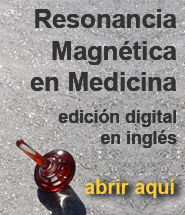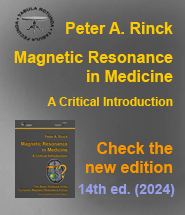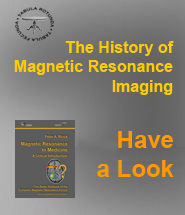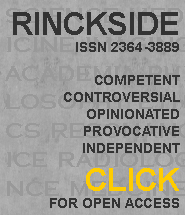20-05 MR Imaging Strikes Roots
The news of Lauterbur's invention traveled slowly although he presented it at a number of scientific meetings between 1972 and 1975. However, some people listened, understood, and reacted. It's a tale of international conferences. Here are some examples:
 |
|
Figure 20-23: Richard Ernst. |
This led to the 1975 publication, 'NMR Fourier Zeugmatography' by Anil Kumar, Dieter Welti, and Richard Ernst [⇒ Kumar], and to the universal reconstruction method for MR imaging today (Figure 20-24).
 |
|
Figure 20-24: |
![]() When Lauterbur presented his approach to NMR imaging at the International Society of Magnetic Resonance (ISMAR) meeting in January 1974 in Bombay, Raymond Andrew, William Moore, and Waldo Hinshaw from the University of Nottingham, England, were in the audience and took note. As a result, Hinshaw developed his own approach to MR imaging with their sensitive point method [⇒ Hinshaw 1974; 1976].
When Lauterbur presented his approach to NMR imaging at the International Society of Magnetic Resonance (ISMAR) meeting in January 1974 in Bombay, Raymond Andrew, William Moore, and Waldo Hinshaw from the University of Nottingham, England, were in the audience and took note. As a result, Hinshaw developed his own approach to MR imaging with their sensitive point method [⇒ Hinshaw 1974; 1976].
At this time, several research groups in Nottingham worked in parallel on similar topics. The first group comprised E. Raymond Andrew, Waldo S. Hinshaw, William S. Moore, Neil Holland, and Paul Bottomley, all of them major contributors to the development of MR imaging. The second group included Peter Mansfield (Figure 20-25), Peter K. Grannell, Andrew Maudsley, Ian Pykett, and Peter Morris. They worked on studies of solid periodic objects, such as crystals.
 |
|
Figure 20-25: Peter Mansfield (1933-2017). |
 |
|
Figure 20-26: |
 |
|
For some time in 1974 a third, single-man research ‘team’ existed in Nottingham, consisting of Alan N. Garroway (Figure 20-27). Figure 20-27: Alan N. Garroway. |
He applied weak radiofrequency pulses in the presence of a field gradient in order to achieve spatial selectivity. Next door, Peter Mansfield and his postdoctoral students were developing a related method. Garroway later joined the Mansfield group. A month before Garroway and Mansfield submitted their first imaging article to Journal of Physics in 1974 [⇒ Garroway] they applied together for a first patent.
Unfortunately, their method was unsuitable for practical application because it suffered from rapid loss of signal; the problem and its solution were explained by David Hoult from Oxford [⇒ Hoult].
By 1975, Mansfield and Andrew A. Maudsley proposed a line technique which, in 1977, led to the first image of in vivo human anatomy, a cross section through a finger. In 1978, Mansfield presented his first image through the abdomen [⇒ Mansfield 1976 a+b].
 |
|
Echo-planar imaging (EPI), a real-time imaging technique, had been proposed by Mansfield's group in 1977, and the first crude images were shown by Mansfield and Ian Pykett in the same year. Roger Ordidge (Figure 20-28) presented the first EPI movie in 1981. Figure 20-28: Roger Ordidge. |
The breakthrough of EPI came with manifold improvements in many aspects of the associated methodology and instrumentation – from gradient power supply and gradient coil design to pulse sequence development, presented by Pykett and Rzedzian in 1987 [⇒ Pykett]. However, it remained a niche technology in clinical MRI.
 |
|
In 1977, Waldo Hinshaw (Figure 20-29), Paul Bottomley, and Neil Holland, succeeded with an image of the wrist Figure 20-29: Waldo Hinshaw. |
Hinshaw later went to Harvard and then joined the group at the Technicare company, at that time the most advanced scientific group with a commercial – and solid medical applications background.
More human thoracic and abdominal images by different groups and several novel techniques followed, and by 1978, Hugh Clow and Ian R. Young, working at the British company EMI, reported the first transverse NMR image through a human head [⇒ Clow].
 |
|
The group around John Mallard at the University of Aberdeen also performed trailblazing research work. James Hutchison, a physicist (Figure 20-30), Margaret A. Foster, a biologist, and later Bill Edelstein, and their colleagues built their own whole-body MR imaging machine and developed the spin-warp technique. Figure 20-30: Jim Hutchison. |
They published the first image through the body of a mouse in 1974 which was followed by a whole-body image in 1980 (Figure 20-31) [⇒ Hutchison; ⇒ Edelstein].
 |
Figure 20-31:
(a) The first image of a whole mouse was obtained in Aberdeen, Scotland, in March 1974.
(b) The prototype whole-body MR machine in Aberdeen.
At this time, many of the researchers working in Britain went to the United States. It was a major brain-drain for British universities, but there was little money in the British university system. Most of the British researchers stayed abroad, whereas many of the Continental Europeans who worked in the U.S.A. in the late 1970s and early 1980s returned to Europe.
Some of the Europeans had performed quite impressive research in the United States.
Among them was Robert N. Muller who, in 1982, described off-resonance imaging, a technique later dubbed magnetization transfer imaging (Figures 20-32 and 20-33) [⇒ Muller 1983]. Peter A. Rinck et al. described the first in vivo fluorine lung images (Figures 20-32 and 20-33) [⇒ Rinck 1984].
 |
|
Figure 20-32: |
 |
|
Figure 20-33: |
Much of the research done at this time was not published, or only presented as abstracts because of the extremely rapid progress in the different research groups.
![]() In vivo MR Spectroscopy. Actual in vivo NMR spectroscopy took off in Oxford from 1974, with the group of Rex E. Richards and George K. Radda. Among others, David Hoult and David G. Gadian belonged to this group.
In vivo MR Spectroscopy. Actual in vivo NMR spectroscopy took off in Oxford from 1974, with the group of Rex E. Richards and George K. Radda. Among others, David Hoult and David G. Gadian belonged to this group.












